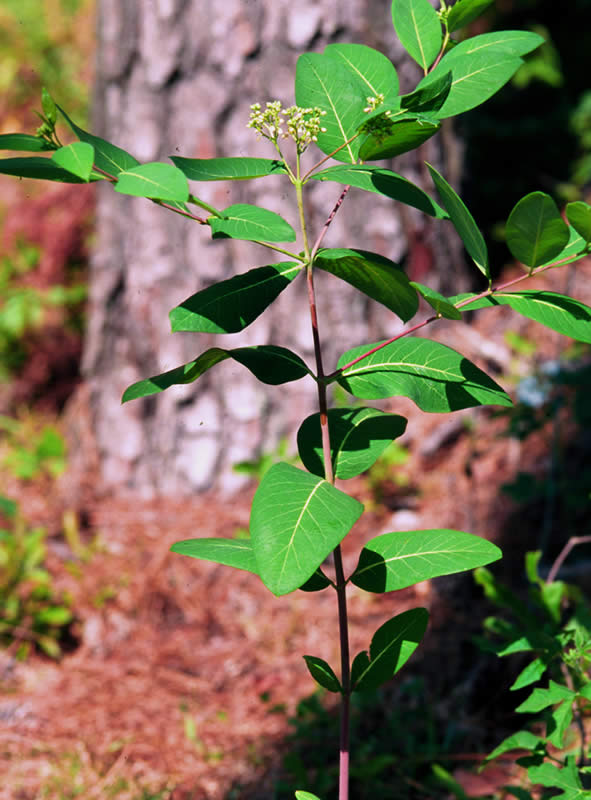Latex
Latex is a thick, creamy white, milky emulsion, although sometimes it may be a thin, clear, yellow or orange, aqueous suspension. Latex has many uses; from clothing to paint, but most importantly is rubber. Latex paint uses synthetic latex as a binder, which is not flammable, has little odor, and cures to form a dry paint film. Natural latex, which is nearly chemical free, is used in the manufacturing of natural latex mattresses, beauty application pads, and cushioning.
Latex is produced in vessels or special cells called laticifers, single cells, or strings of cells that form tubes, canals, or networks in various plant organs. This is quite different from the internal secretory tissues (pockets, cavities, or canals) in which most resin is produced.
Plant families that produce copious amounts of latex include:
- Euphorb family (Euphorbiaceae),
- milkweed family (Asclepiadaceae),
- mulberry family (Moraceae),
- dogbane family (Apocynaceae), and
- chicory tribe (Lactuceae) of the sunflower family (Asteraceae).
The first European notice of rubber was by Columbus in the Caribbean and by Cortez in Mexico, where crude rubber balls were noted as playthings of the American Indians.
In California and the southwest, many acres of guayule (Parthenium argentatum), pronounced "wa-YOO-lee," were planted to decrease the United States' dependence on foreign sources of rubber during World War II. The fields were later destroyed or abandoned with the advent of synthetic rubber.
The diminishing acreage of rubber plantations, an increasing demand, and the life-threatening latex allergy to Hevea rubber have prompted research interests in the development of alternative rubber sources, such as guayule, a native to Texas and Mexico.
Rubber rabbitbrush (Ericameria nauseosa) is a native source of latex, used in making rubber. However, there is no commercially viable method of extracting it yet. Native American peoples used rubber rabbitbrush as a source of rich yellow dye for blankets and rugs and the latex as a source of chewing gum.
Did you know?
 Showy milkweed (Asclepias speciosa) is another common 3 to 4 foot tall milkweed and a favorite host plant of tiger-swallowtail butterfly larvae. Thick, milky latex (sap) is present in all parts of the plant. Photo by Teresa Prendusi.
Showy milkweed (Asclepias speciosa) is another common 3 to 4 foot tall milkweed and a favorite host plant of tiger-swallowtail butterfly larvae. Thick, milky latex (sap) is present in all parts of the plant. Photo by Teresa Prendusi.
- Ninety percent of all natural rubber comes from the Brazilian rubber tree, Hevea brasiliensis, which is native to the Amazon Basin and a member of the euphorbia family. Among more than 2,000 plant species known to produce natural rubber, the Brazilian rubber tree is the only commercial source at present.
- In World War II, because of the shortage of natural rubber, scientists in the United States tried to turn common milkweed’s latex into a rubber-like substitute.
- Common milkweed, Asclepias syriaca, is native to North America and is one of the most important northern plants for the monarch butterfly.
- Monarch caterpillars and butterflies are bitter and poisonous to birds, due to a toxic alkaloid in the latex.
- Viceroy butterflies resemble or mimic monarchs, but are not poisonous. Birds usually avoid eating either species.
- In humans, milkweed’s latex can produce dermatitis in susceptible individuals. However, this latex was also used by Native Americans to remove corns and calluses.
 The Indian Hemp (Apocynum cannabinum) plant contains a milky latex that is toxic to many animals and prevents herbivory. However, its lovely pink flowers are attractive to butterflies, bees and other pollinators. Photo by James H. Miller @ Forestryimages.org.
The Indian Hemp (Apocynum cannabinum) plant contains a milky latex that is toxic to many animals and prevents herbivory. However, its lovely pink flowers are attractive to butterflies, bees and other pollinators. Photo by James H. Miller @ Forestryimages.org.
 Guayule (Parthenium argentatum) was used as a source of rubber in World World II. Clarence A. Rechenthin @ USDA-NRCS PLANTS Database.
Guayule (Parthenium argentatum) was used as a source of rubber in World World II. Clarence A. Rechenthin @ USDA-NRCS PLANTS Database.
 Rubber rabbitbrush (Ericameria nauseosa) is associated with sagebrush ecosystems in the western U.S. This showy late-summer bloomer with aromatic leaves produces significant amounts of high-grade rubber and oleoresins. It is currently being investigated as a potential biodiesel and bioenergy crop in Nevada. Photo by Teresa Prendusi.
Rubber rabbitbrush (Ericameria nauseosa) is associated with sagebrush ecosystems in the western U.S. This showy late-summer bloomer with aromatic leaves produces significant amounts of high-grade rubber and oleoresins. It is currently being investigated as a potential biodiesel and bioenergy crop in Nevada. Photo by Teresa Prendusi.

